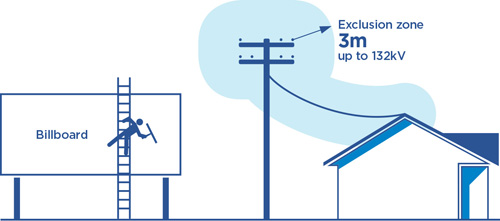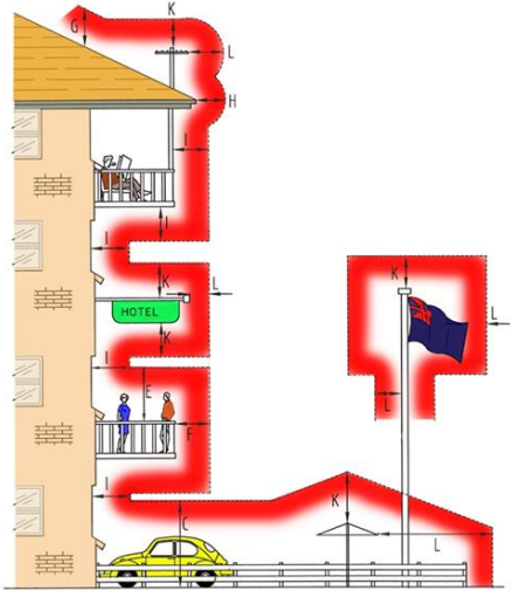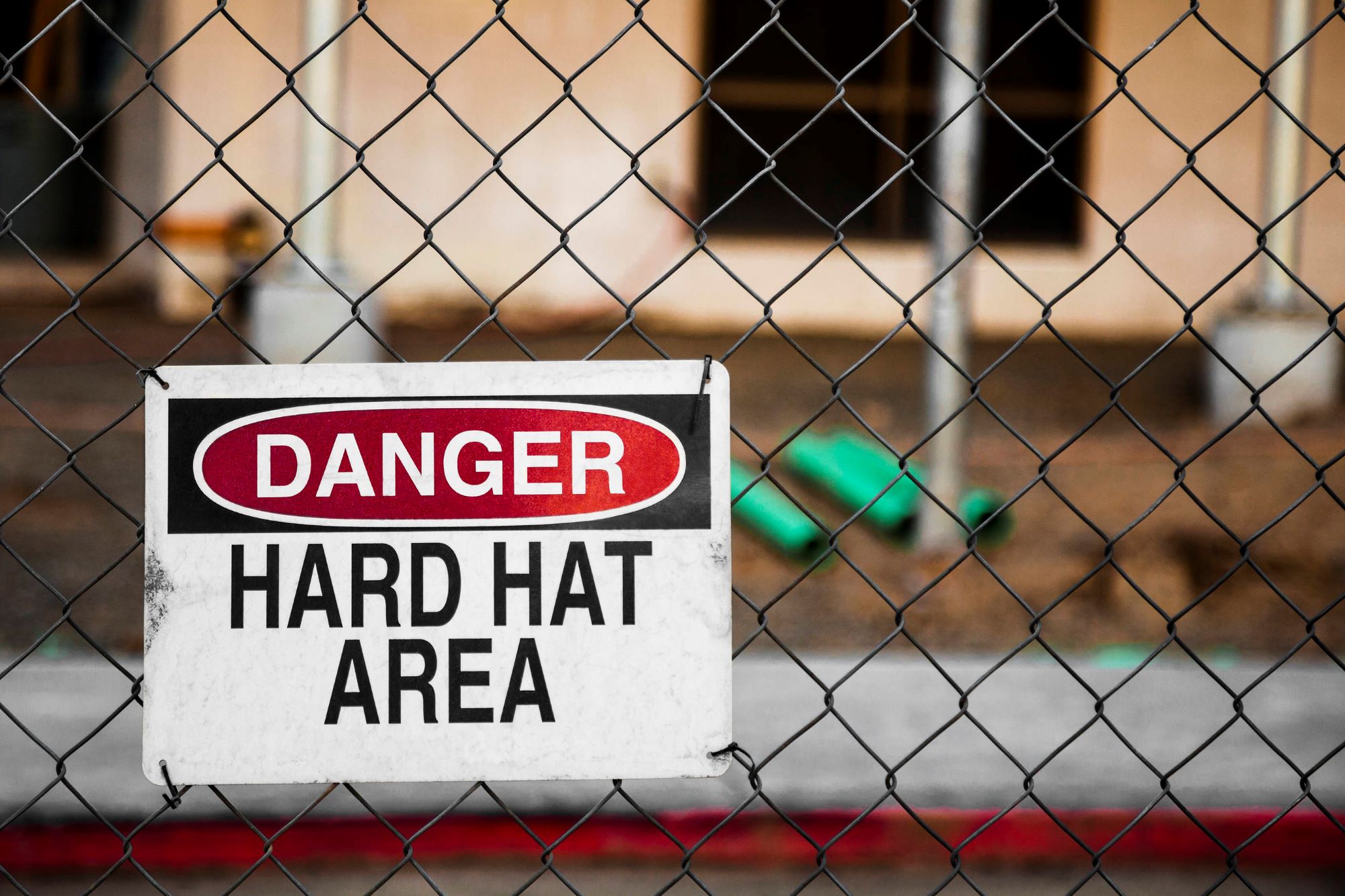Structures & billboards
Any time you’re working above ground level you’re likely working closer to our powerlines.
Remember any time you climb a ladder or use tall equipment. Always use safe work habits to reduce your risk of electrical accidents.
Understanding the risks
Some work activities have a higher risk of contact with energised cables. This could cause power outages, equipment damage or give you a life-threatening electric shock. This includes jobs like:
- moving the location of a driveway or building driveways close to pillars or poles
- installing a tall antenna in areas where broadcast reception is poor
- erecting a flagpole or shade sails
- building a cubby house
- raising the ground level below powerlines
- building metal fences or scaffolding close to poles or powerlines
- excavating near poles, stay wires or where electricity assets run underground
- using a crane near overhead powerlines
- building or maintaining signs or billboards
- building sheds
- building carports below points of attachments
- any building work near overhead or underground powerlines.
Other jobs might bring you close to a point of attachment, which is where the electrical service wires attach to a home or building. This includes activities like:
- cleaning leaves from guttering
- painting gutters, fascias and eaves
- replacing the roofing or the guttering
- pruning trees and shrubs.
What are my responsibilities?
If you’re in charge of your job, you must take reasonable steps to protect your workers from electrical hazards. See the Electrical Safety Codes of Practice and Electrical Entity Requirements (PDF 681.8 kb) for more about your legal requirements for worker safety.
If you’re a worker, look for electrical hazards at the start of each shift and continue monitoring them while you work. Then, use the following safe work habits.
How to work safe
First, consult with us during your project’s planning stage. We’ll check that none of your proposed buildings or equipment (e.g. scaffolding, cranes) will enter a powerline exclusion zone during construction. Find out more about exclusion zones.

Then, use a simple risk management process (like the one below) to identify electrical hazards, assess risks and plan safe work habits.
Minimum required clearances to powerlines
Minimum clearances from structures and buildings
| Image code (see below) | Location | Direction | Insulated powerline | Bare powerline | More than 1000 volts but less than 33kV |
|---|---|---|---|---|---|
| E F | Unroofed terraces, balconies, sundecks, paved areas etc. subject to pedestrian traffic only. A handrail or wall surrounding such an area and on which a person may stand. | Vertically* Horizontally* | 2.7 metres 1.2 metres | 3.7 metres 1.5 metres | 4.6 metres 2.1 metres |
| G H | Roofs or similar structures not used for traffic or resort but on which a person may stand. | Vertically* Horizontally* | 2.7 metres 0.9 metres | 3.7 metres 1.5 metres | 3.7 metres 2.1 metres |
| I | Covered places of traffic or resort such as windows which are capable of being opened, roofed open verandahs and covered balconies. | In any direction | 1.2 metres | 1.5 metres | 2.1 metres |
| Blank walls, windows which cannot be opened. | Horizontally | 0.6 metres | 1.5 metres | 1.5 metres | |
| K L | Other structures not normally accessible to persons. | Vertically* Horizontally* | 0.6 metres 0.3 metres | 2.7 metres 1.5 metres | 3.0 metres 1.5 metres |
*Note: The vertical clearance or horizontal clearance must be maintained.
The letters in this image correspond to the image codes in the table above.

Simple risk management process
1. Identify electrical hazards
Check your work area for electrical hazards at the start of each day and as conditions change. These are objects or tasks that could cause damage or injury, like a power pole or moving a forklift under powerlines.
To spot electrical hazards:
- Check the location of powerlines and other electrical infrastructure by
- locating overhead powerlines visually or using our Look up and Live map
- locating underground powerlines using the Before You Dig Australia service
- noting the exclusion zone distances for each overhead powerline
- Check for changing conditions that could create new hazards, like
- heat causing powerlines to sag, reducing clearance
- high winds causing lines to sway or fall
- lower light at dawn/dusk causing reduced visibility
- damaged power poles reducing clearance
- Check that your equipment and machinery
- is in good working order, with no signs of damage
- will not pass into any powerline exclusion zones in the course of your job.
If you’re a worker, tell the person in charge about any hazards and stay well clear.
If you’re in charge, you need to assess the risk posed by each electrical hazard, before deciding on what action to take. You can find detailed guidance in the Electrical Safety Codes of Practice and Electrical Entity Requirements (PDF 681.8 kb).
IMPORTANT: Stay well clear of damaged powerlines and report them immediately by calling Triple zero (000).
2. Use safe work habits
When you can’t remove a hazard, you can use safe work habits to reduce the risk. You can do this by:
- requesting us to install powerline markers on overhead powerlines
- assigning a safety observer to guide machinery movements near overhead powerlines
- taking care when working near attachment points and avoid contact with wiring, mounting brackets and mains box
- monitoring that people and equipment stay outside powerline exclusion zones, especially when conditions cause lines to sag or sway
- lowering all machinery and equipment to the lowest point before relocating
- advising machinery and delivery vehicle operators of powerline locations
- carrying out all maintenance and storage activities well away from powerlines.
Want more information?
FAQs
If you have more questions, you might find answers in our Frequently Asked Questions.
Safety fact sheets
Download our fact sheets for information about working safely:
- Buildings, structures and billboards (PDF 1.4 mb)
- Fire and high voltage powerlines safety (PDF 1.4 mb)
- Look Up and Live – Exclusion zones (PDF 624.9 kb)
- Marking overhead powerlines and electrical assets (PDF 1.8 mb)
- Trees and powerlines (PDF 1.8 mb)
To order factsheets in industry packs, use our Brochure & sticker order form.
Marking powerlines on your site
Find out about powerline markers and how to increase the visibility of powerlines on your property. Marking powerlines is especially important when operating large machinery on your property.
Awareness sessions
We offer training sessions to help your team work safely near overhead and underground powerlines. These sessions can be targeted for conferences, business groups, local councils or emergency services groups. Topics include exclusion zones, safety observer zones and how to safely operate plant and vehicles near powerlines.
If you would like to book a session for your conference or staff, please email us and we'll contact you to discuss a suitable time.
Other forms and guidelines
Links to some popular request forms and information.

